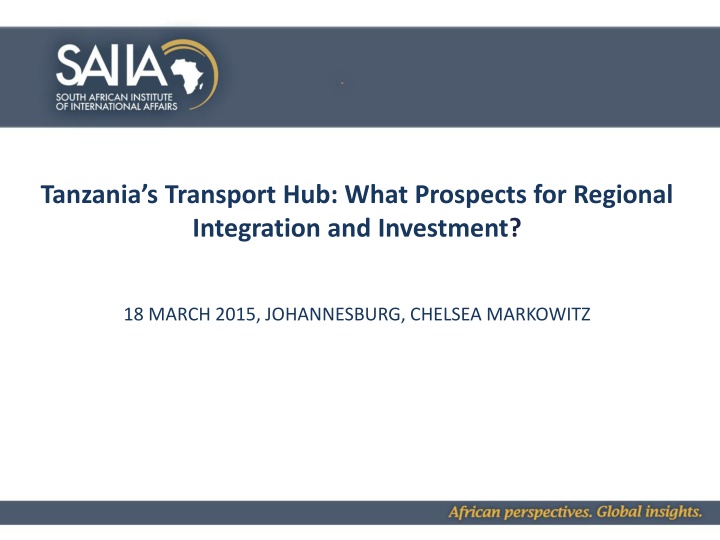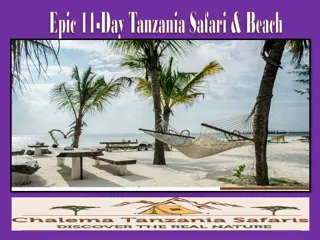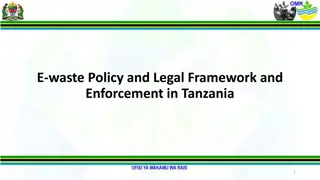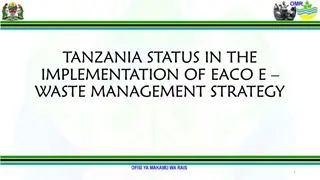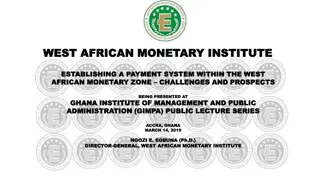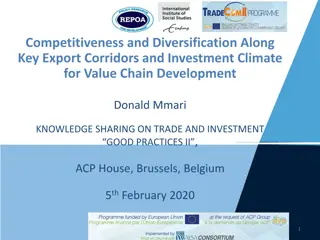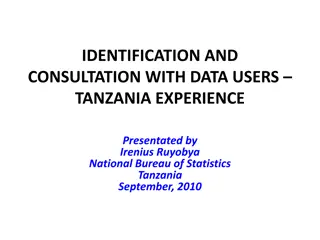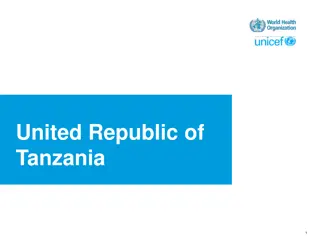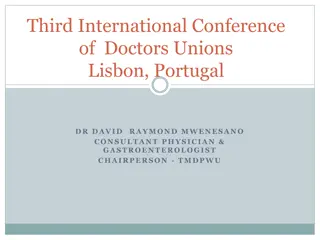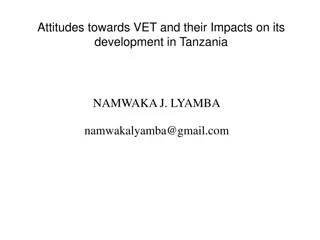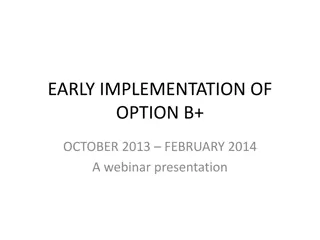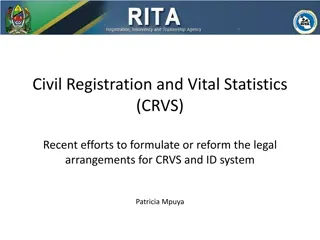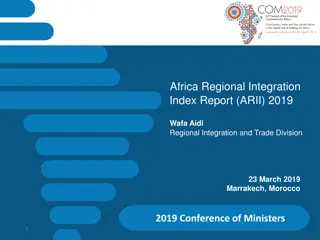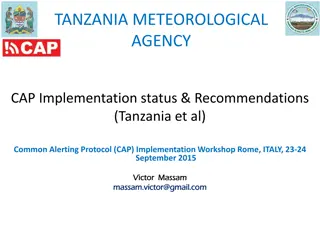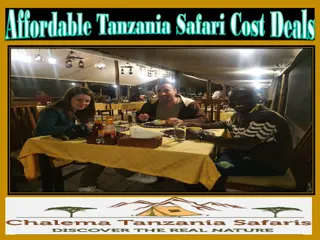Prospects for Regional Integration and Investment in Tanzania's Transport Hub
This article explores the current condition of transportation infrastructure in Tanzania, focusing on ports, transport corridors, regional integration, financing, and key insights. It delves into the challenges and future initiatives in the sector, including insufficient public finance, FDI in the transport sector, and initiatives for regional connectivity. The discussion also covers the Dar es Salaam port, the Central Corridor, and the TRL and TAZARA rail networks. Overall, the article provides a comprehensive overview of the opportunities and obstacles in Tanzania's transport industry.
Download Presentation

Please find below an Image/Link to download the presentation.
The content on the website is provided AS IS for your information and personal use only. It may not be sold, licensed, or shared on other websites without obtaining consent from the author.If you encounter any issues during the download, it is possible that the publisher has removed the file from their server.
You are allowed to download the files provided on this website for personal or commercial use, subject to the condition that they are used lawfully. All files are the property of their respective owners.
The content on the website is provided AS IS for your information and personal use only. It may not be sold, licensed, or shared on other websites without obtaining consent from the author.
E N D
Presentation Transcript
Tanzanias Transport Hub: What Prospects for Regional Integration and Investment? 18 MARCH 2015, JOHANNESBURG, CHELSEA MARKOWITZ
OUTLINE 1. Current Condition of Transport Infrastructure in Tanzania 2. Ports 3. Transport Corridors and Regional Integration 4. Financing/Investment For Transport Infrastructure 5. Current Developments 6. Key Insights
CURRENT CONDITION OF TRANSPORT INFRASTRUCTURE IN TANZANIA Transportation infrastructure in need of critical improvement WEF: 127/140 infrastructure development. 2016 Budget Speech: over Sh4.9 trillion for infrastructure development (46% of national dev budget), Sh2.9 trillion on transport infrastructure Develop the Central Corridor
DAR ES SALAAM PORT Port of Dar es Salaam 16 million tons of cargo/yr Managed by TPA & TICTS Average dwell time: 9-10 days
REGIONAL INTEGRATION & TRANSPORT CORRIDORS Dar es Salaam Corridor Central Corridor - TRL rail: Dar es Salaam- Mwanza- Kigoma - Access to Rwanda, Burundi, Uganda, DRC - TAZARA rail: Dar es Salaam- Mbeya - Failed concession to RITES India in 2004 - Challenges: age, floods, major finance, priorities - Access to Zambia, Malawi -Currently cargo less than 1%
REGIONAL INTEGRATION & TRANSPORT CORRIDORS Future Initiatives EAC Common Market Free movement of goods, labour, services and capital North- South Corridor Programme Linking Dar to Durban
FINANCING FOR TRANSPORT INFRASTRUCTURE Insufficient public finance TRL Budget Constraints 2014-15 Reqd: 164.2 bn Approved: 60.7 bn Disbursed: 11.7 bn 2015-16 Reqd: 309 Bn Approved: 31.6 bn Reliance on donor funds Key priority for transport sector in BRN campaign is to involve private sector PPPs (National PPP Act, 2010) Domestic private sector FDI Challenges of PPPs Vertical and horizontal integration needed Understanding, risks Capacity constraints
FDI IN TRANSPORT Sector FDI Stock 2013 ($USD Million) Mining & Quarrying 6825.2 Manufacturing 2409.9 Financial & Insurance 1629.0 Electricity & Gas 1182.3 Accommodation 663.8 Wholesale & Retail Trade 594.8 Information & Comm. 478.5 Agriculture 307.1 Professional Activities 240.6 Construction 127.2 Real Estate Activities 117.5 Transportation & Storage 65.6 Other Service Sectors 32.3 Education 8.4
POTENTIAL OF PPPS WITH FDI Trend toward concessioning operations of major transport infrastructure to foreign entities Capital (equipment), new technologies, efficiency Tanzania TICTS concessioned: dwell times down by 5 days, computerised, fully automated $20 million for new cranes TRL failed railway concession Challenges: Facilitating PP understanding Other countries Nigeria: Lagos Port Complex concessioned 25 terminals
SUSTAINABLE FDI IN TRANSPORT INFRASTRUCTURE FDI can bring economic benefit, also needs to be sustainable: performance requirements Training, employment, technology transfer, local contracting Extractives: Petroleum Act of 2015 Other sectors? National Economic Empowerment Council (NEEC) recent drive to understand how other sectors can benefit from performance requirements
SUSTAINABLE FDI IN TRANSPORT INFRASTRUCTURE Generally employ locally in construction, joint ventures encouraged Concern with Chinese FDI Capacitate private sector in PPPs>> contracting of local companies for maintenance Issue with channel to from VETA to workforce, esp higher management Lack of experience
CURRENT DEVELOPMENTS World Bank, DfID, TMEA Improving access roads, dredging, moving oil jetty, berths 12-14 WB PPP capacity programme CCTTFA: One-Stop-Inspection Post(54 to 6 police checks), One-Stop-Border-Post (3-4 days to hours) Proposed Bagamoyo Port (China Merchant Holdings) Standard Gauge Railway (China)
THE IMPACT OF PRESIDENT MAGUFULI No nonsense approach to corruption is positive. Made positive changes in the TPA, reshuffling which has made it much more efficient Former minister of Works has an understanding of the issues in transport, good track record At the same time, uncertainty regarding his attitude toward businesses
KEY INSIGHTS Upgrade of the port progressing Prioritisation of rail is positive Strategic and focused planning for a bankable project FDI (PPPs) as an alternative source of funding, if sustainable FDI Sustainability Facilitating abroad training programmes, incentives based localisation, joint ventures Further localise VCs: assembly, production. Ex. Iron ore>Steel>Rail Develop rural feeder roads to new transport infra Concessionary Agreements need to facilitate understanding from both parties
